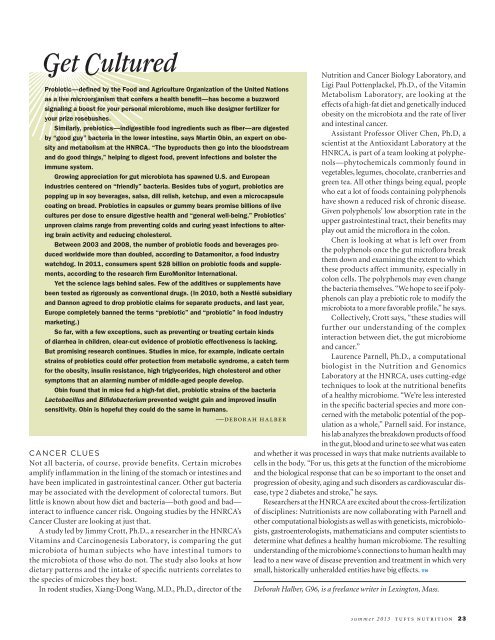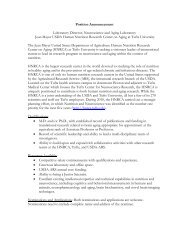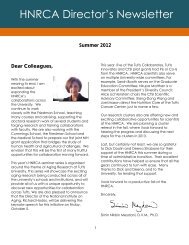Microbiome - Human Nutrition Research Center on Aging - Tufts ...
Microbiome - Human Nutrition Research Center on Aging - Tufts ...
Microbiome - Human Nutrition Research Center on Aging - Tufts ...
You also want an ePaper? Increase the reach of your titles
YUMPU automatically turns print PDFs into web optimized ePapers that Google loves.
Get Cultured<br />
Probiotic—defined by the Food and Agriculture Organizati<strong>on</strong> of the United Nati<strong>on</strong>s<br />
as a live microorganism that c<strong>on</strong>fers a health benefit—has become a buzzword<br />
signaling a boost for your pers<strong>on</strong>al microbiome, much like designer fertilizer for<br />
your prize rosebushes.<br />
Similarly, prebiotics—indigestible food ingredients such as fiber—are digested<br />
by “good guy” bacteria in the lower intestine, says Martin Obin, an expert <strong>on</strong> obesity<br />
and metabolism at the HNRCA. “The byproducts then go into the bloodstream<br />
and do good things,” helping to digest food, prevent infecti<strong>on</strong>s and bolster the<br />
immune system.<br />
Growing appreciati<strong>on</strong> for gut microbiota has spawned U.S. and European<br />
industries centered <strong>on</strong> “friendly” bacteria. Besides tubs of yogurt, probiotics are<br />
popping up in soy beverages, salsa, dill relish, ketchup, and even a microcapsule<br />
coating <strong>on</strong> bread. Probiotics in capsules or gummy bears promise billi<strong>on</strong>s of live<br />
cultures per dose to ensure digestive health and “general well-being.” Probiotics’<br />
unproven claims range from preventing colds and curing yeast infecti<strong>on</strong>s to altering<br />
brain activity and reducing cholesterol.<br />
Between 2003 and 2008, the number of probiotic foods and beverages produced<br />
worldwide more than doubled, according to Datam<strong>on</strong>itor, a food industry<br />
watchdog. In 2011, c<strong>on</strong>sumers spent $28 billi<strong>on</strong> <strong>on</strong> probiotic foods and supplements,<br />
according to the research firm EuroM<strong>on</strong>itor Internati<strong>on</strong>al.<br />
Yet the science lags behind sales. Few of the additives or supplements have<br />
been tested as rigorously as c<strong>on</strong>venti<strong>on</strong>al drugs. (In 2010, both a Nestlé subsidiary<br />
and Dann<strong>on</strong> agreed to drop probiotic claims for separate products, and last year,<br />
Europe completely banned the terms “prebiotic” and “probiotic” in food industry<br />
marketing.)<br />
So far, with a few excepti<strong>on</strong>s, such as preventing or treating certain kinds<br />
of diarrhea in children, clear-cut evidence of probiotic effectiveness is lacking.<br />
But promising research c<strong>on</strong>tinues. Studies in mice, for example, indicate certain<br />
strains of probiotics could offer protecti<strong>on</strong> from metabolic syndrome, a catch term<br />
for the obesity, insulin resistance, high triglycerides, high cholesterol and other<br />
symptoms that an alarming number of middle-aged people develop.<br />
Obin found that in mice fed a high-fat diet, probiotic strains of the bacteria<br />
Lactobacillus and Bifidobacterium prevented weight gain and improved insulin<br />
sensitivity. Obin is hopeful they could do the same in humans.<br />
—deborah halber<br />
CANCER CLUES<br />
Not all bacteria, of course, provide benefits. Certain microbes<br />
amplify inflammati<strong>on</strong> in the lining of the stomach or intestines and<br />
have been implicated in gastrointestinal cancer. Other gut bacteria<br />
may be associated with the development of colorectal tumors. But<br />
little is known about how diet and bacteria—both good and bad—<br />
interact to influence cancer risk. Ongoing studies by the HNRCA’s<br />
Cancer Cluster are looking at just that.<br />
A study led by Jimmy Crott, Ph.D., a researcher in the HNRCA’s<br />
Vitamins and Carcinogenesis Laboratory, is comparing the gut<br />
microbiota of human subjects who have intestinal tumors to<br />
the microbiota of those who do not. The study also looks at how<br />
dietary patterns and the intake of specific nutrients correlates to<br />
the species of microbes they host.<br />
In rodent studies, Xiang-D<strong>on</strong>g Wang, M.D., Ph.D., director of the<br />
<str<strong>on</strong>g>Nutriti<strong>on</strong></str<strong>on</strong>g> and Cancer Biology Laboratory, and<br />
Ligi Paul Pottenplackel, Ph.D., of the Vitamin<br />
Metabolism Laboratory, are looking at the<br />
effects of a high-fat diet and genetically induced<br />
obesity <strong>on</strong> the microbiota and the rate of liver<br />
and intestinal cancer.<br />
Assistant Professor Oliver Chen, Ph.D, a<br />
scientist at the Antioxidant Laboratory at the<br />
HNRCA, is part of a team looking at polyphenols—phytochemicals<br />
comm<strong>on</strong>ly found in<br />
vegetables, legumes, chocolate, cranberries and<br />
green tea. All other things being equal, people<br />
who eat a lot of foods c<strong>on</strong>taining polyphenols<br />
have shown a reduced risk of chr<strong>on</strong>ic disease.<br />
Given polyphenols’ low absorpti<strong>on</strong> rate in the<br />
upper gastrointestinal tract, their benefits may<br />
play out amid the microflora in the col<strong>on</strong>.<br />
Chen is looking at what is left over from<br />
the polyphenols <strong>on</strong>ce the gut microflora break<br />
them down and examining the extent to which<br />
these products affect immunity, especially in<br />
col<strong>on</strong> cells. The polyphenols may even change<br />
the bacteria themselves. “We hope to see if polyphenols<br />
can play a prebiotic role to modify the<br />
microbiota to a more favorable profile,” he says.<br />
Collectively, Crott says, “these studies will<br />
further our understanding of the complex<br />
interacti<strong>on</strong> between diet, the gut microbiome<br />
and cancer.”<br />
Laurence Parnell, Ph.D., a computati<strong>on</strong>al<br />
biologist in the <str<strong>on</strong>g>Nutriti<strong>on</strong></str<strong>on</strong>g> and Genomics<br />
Laboratory at the HNRCA, uses cutting-edge<br />
techniques to look at the nutriti<strong>on</strong>al benefits<br />
of a healthy microbiome. “We’re less interested<br />
in the specific bacterial species and more c<strong>on</strong>cerned<br />
with the metabolic potential of the populati<strong>on</strong><br />
as a whole,” Parnell said. For instance,<br />
his lab analyzes the breakdown products of food<br />
in the gut, blood and urine to see what was eaten<br />
and whether it was processed in ways that make nutrients available to<br />
cells in the body. “For us, this gets at the functi<strong>on</strong> of the microbiome<br />
and the biological resp<strong>on</strong>se that can be so important to the <strong>on</strong>set and<br />
progressi<strong>on</strong> of obesity, aging and such disorders as cardiovascular disease,<br />
type 2 diabetes and stroke,” he says.<br />
<str<strong>on</strong>g>Research</str<strong>on</strong>g>ers at the HNRCA are excited about the cross-fertilizati<strong>on</strong><br />
of disciplines: <str<strong>on</strong>g>Nutriti<strong>on</strong></str<strong>on</strong>g>ists are now collaborating with Parnell and<br />
other computati<strong>on</strong>al biologists as well as with geneticists, microbiologists,<br />
gastroenterologists, mathematicians and computer scientists to<br />
determine what defines a healthy human microbiome. The resulting<br />
understanding of the microbiome’s c<strong>on</strong>necti<strong>on</strong>s to human health may<br />
lead to a new wave of disease preventi<strong>on</strong> and treatment in which very<br />
small, historically unheralded entities have big effects. TN<br />
Deborah Halber, G96, is a freelance writer in Lexingt<strong>on</strong>, Mass.<br />
summer 2013 tufts nutriti<strong>on</strong> 23







